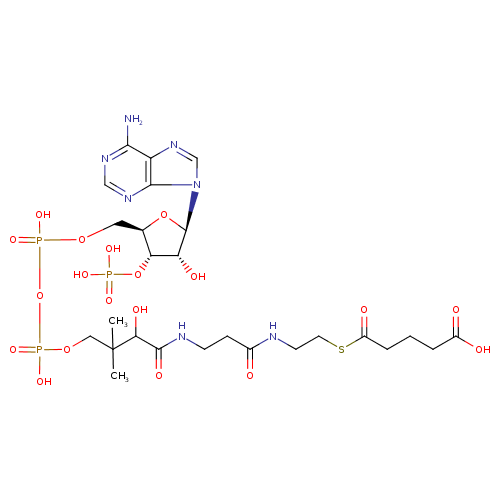|
Record Information |
|---|
| Version |
1.0 |
|---|
| Update Date |
1/22/2018 11:54:54 AM |
|---|
|
Metabolite ID | PAMDB110379 |
|---|
|
Identification |
|---|
| Name: |
glutaryl-CoA |
|---|
| Description: | An acyl-CoA oxoanion that is the pentaanion of glutaryl-CoA arising from deprotonation of phosphate, diphosphate and carboxylic acid functions. |
|---|
|
Structure |
|
|---|
| Synonyms: | -
glutaryl-coenzyme A
-
4-carboxybutanoyl-CoA
|
|---|
|
Chemical Formula: |
C26H37N7O19P3S
|
|---|
| Average Molecular Weight: |
876.6 |
|---|
| Monoisotopic Molecular
Weight: |
881.1469024245 |
|---|
| InChI Key: |
SYKWLIJQEHRDNH-CKRMAKSASA-I |
|---|
| InChI: |
InChI=1S/C26H42N7O19P3S/c1-26(2,21(39)24(40)29-7-6-15(34)28-8-9-56-17(37)5-3-4-16(35)36)11-49-55(46,47)52-54(44,45)48-10-14-20(51-53(41,42)43)19(38)25(50-14)33-13-32-18-22(27)30-12-31-23(18)33/h12-14,19-21,25,38-39H,3-11H2,1-2H3,(H,28,34)(H,29,40)(H,35,36)(H,44,45)(H,46,47)(H2,27,30,31)(H2,41,42,43)/p-5/t14-,19-,20-,21+,25-/m1/s1 |
|---|
| CAS
number: |
103192-48-9 |
|---|
| IUPAC Name: | 3'- phosphonatoadenosine 5'- phosphonatoadenosine 5'- {3- {3- [(3R)- [(3R)- 4- 4- {[3- {[3- ({2- ({2- [(4- [(4- carboxylatobutanoyl)sulfanyl]ethyl}amino)- carboxylatobutanoyl)sulfanyl]ethyl}amino)- 3- 3- oxopropyl]amino}- oxopropyl]amino}- 3- 3- hydroxy- hydroxy- 2,2- 2,2- dimethyl- dimethyl- 4- 4- oxobutyl] diphosphate} oxobutyl] diphosphate} |
|---|
|
Traditional IUPAC Name: |
5-({2-[3-(3-{[({[(2R,3S,4R,5R)-5-(6-aminopurin-9-yl)-4-hydroxy-3-(phosphonooxy)oxolan-2-yl]methoxy(hydroxy)phosphoryl}oxy(hydroxy)phosphoryl)oxy]methyl}-2-hydroxy-3-methylbutanamido)propanamido]ethyl}sulfanyl)-5-oxopentanoic acid |
|---|
| SMILES: | CC(C)(C(O)C(=O)NCCC(=O)NCCSC(CCCC(=O)[O-])=O)COP(=O)(OP(=O)(OCC1(C(OP([O-])(=O)[O-])C(O)C(O1)N3(C2(=C(C(N)=NC=N2)N=C3))))[O-])[O-] |
|---|
|
Chemical Taxonomy |
|---|
|
Taxonomy Description | This compound belongs to the class of chemical entities known as 2,3,4-saturated fatty acyl coas. These are acyl-CoAs carrying a 2,3,4-saturated fatty acyl chain. |
|---|
|
Kingdom |
Chemical entities |
|---|
| Super Class | Organic compounds |
|---|
|
Class |
Lipids and lipid-like molecules |
|---|
| Sub Class | Fatty Acyls |
|---|
|
Direct Parent |
2,3,4-saturated fatty acyl CoAs |
|---|
| Alternative Parents |
|
|---|
| Substituents |
- Coenzyme a or derivatives
- Purine ribonucleoside 3',5'-bisphosphate
- Purine ribonucleoside bisphosphate
- Purine ribonucleoside diphosphate
- Pentose phosphate
- Pentose-5-phosphate
- Ribonucleoside 3'-phosphate
- Beta amino acid or derivatives
- Glycosyl compound
- N-glycosyl compound
- Monosaccharide phosphate
- Organic pyrophosphate
- 6-aminopurine
- Pentose monosaccharide
- Imidazopyrimidine
- Purine
- Monoalkyl phosphate
- Aminopyrimidine
- Fatty amide
- Imidolactam
- Monosaccharide
- N-acyl-amine
- N-substituted imidazole
- Organic phosphoric acid derivative
- Alkyl phosphate
- Phosphoric acid ester
- Primary aromatic amine
- Pyrimidine
- Oxolane
- Azole
- Heteroaromatic compound
- Imidazole
- Thiocarboxylic acid ester
- Amino acid or derivatives
- Secondary carboxylic acid amide
- Secondary alcohol
- Carboxamide group
- Carbothioic s-ester
- Amino acid
- Azacycle
- Oxacycle
- Carboxylic acid derivative
- Monocarboxylic acid or derivatives
- Thiocarboxylic acid or derivatives
- Organoheterocyclic compound
- Carboxylic acid
- Sulfenyl compound
- Hydrocarbon derivative
- Organic nitrogen compound
- Alcohol
- Amine
- Organonitrogen compound
- Carbonyl group
- Organooxygen compound
- Organosulfur compound
- Organic oxygen compound
- Organopnictogen compound
- Primary amine
- Organic oxide
- Aromatic heteropolycyclic compound
|
|---|
| Molecular Framework |
Aromatic heteropolycyclic compounds |
|---|
| External Descriptors |
Not Available |
|---|
|
Physical Properties |
|---|
| State: |
Solid |
|---|
| Charge: | -5 |
|---|
|
Melting point: |
Not Available |
|---|
| Experimental Properties: |
| Property | Value | Reference |
|---|
| Melting Point | Not Available | Not Available | | Boiling Point | Not Available | Not Available | | Water Solubility | Not Available | Not Available | | LogP | Not Available | Not Available |
|
|---|
| Predicted Properties |
|
|---|
|
Biological Properties |
|---|
| Cellular Locations: |
Not Available |
|---|
| Reactions: | |
|---|
|
Pathways: |
|
|---|
|
Spectra |
|---|
| Spectra: |
|
|---|
|
References |
|---|
| References: |
- Corral I, Martinez Castrillo JC, Martinez-Pardo M, Gimeno A: [Glutaric aciduria type I: diagnosis in adulthood and phenotypic variability] Neurologia. 2001 Oct;16(8):377-80. [11738016 ]
- Mahfoud A, Dominguez CL, Rizzo C, Ribes A: [In utero macrocephaly as clinical manifestation of glutaric aciduria type I. Report of a novel mutation] Rev Neurol. 2004 Nov 16-30;39(10):939-42. [15573311 ]
- Hyman DB, Tanaka K: Specific glutaryl-CoA dehydrogenating activity is deficient in cultured fibroblasts from glutaric aciduria patients. J Clin Invest. 1984 Mar;73(3):778-84. [6423663 ]
|
|---|
| Synthesis Reference: |
Not Available |
|---|
| Material Safety Data Sheet (MSDS) |
Not Available |
|---|
|
Links |
|---|
| External Links: |
|
|---|


